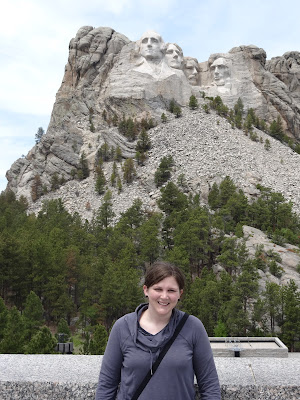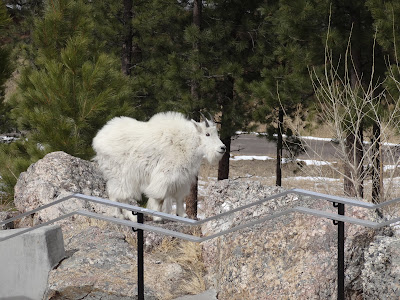Visited: June 2013, April 2018
Nearby town: Keystone, SD
The Black Hills of southwestern South Dakota are a magical destination. And the crown jewel of the Black Hills is magnificent Mount Rushmore. The giant heads of four great presidents on the mountainside is one of the most iconic landmarks in the nation. It is so iconic that the word "Rushmore" itself has become a superlative describing someone who has achieved outstanding success in their field.
The Black Hills of southwestern South Dakota are a magical destination. And the crown jewel of the Black Hills is magnificent Mount Rushmore. The giant heads of four great presidents on the mountainside is one of the most iconic landmarks in the nation. It is so iconic that the word "Rushmore" itself has become a superlative describing someone who has achieved outstanding success in their field.
The impressive sculpture is the brainchild of historian Doane Robinson, who wanted to have some kind of giant carving in the Black Hills as a way to create a monument to American history and increase tourism in the area. In the early 1920s Robinson met with Gutzon Borglum, a prominent artist and sculptor who had recently quit working on the Stone Mountain carving in Georgia due to creative differences, to discuss possible locations. Robinson wanted the sculpture to be in the Needles, in the heart of the Black Hills, but Borglum realized that the granite of the Needles was much too weak and of low quality and it could not support such a massive carving. The southeast face of Mount Rushmore was chosen as a much more appropriate setting. Robinson also wanted the carvings to be of heroes of the American West, like Lewis and Clark, Buffalo Bill Cody, and Red Cloud. Borglum felt there would be broader appeal if Founding Fathers/Presidents were the subject. After securing funding thanks to the efforts of South Dakota governor and US Senator, Peter Norbeck, construction on the project began in 1927. For the next 14 years, Borglum and over 400 workers laboriously carved the mountainside. Borglum passed away in 1941, when the work was near completion, it was finished by his son Lincoln Borglum. The sculpture was originally planned to include most of the upper torsos of the Presidents, this original model can be seen in Borglum's studio at the monument.
Due to lack of funding the idea was abandoned and just the heads were completed. The carving was mostly completed by the use of dynamite. Workers would also drill holes into the granite in a process called "honeycombing" to remove small pieces of rock from the mountain. Workers would sit in these chairs to do the drilling, dangling precariously hundreds of feet in the air. They are also on display at the studio.
Amazingly, no workers died in the construction of Mt. Rushmore. On October 31, 1941, the project was finally complete. In the decades since, millions of visitors have gazed in wonder and admiration at this majestic and amazing site. Entrance into the park is free, but you will have to pay for parking if you arrive by car ($10, its good for a year). The walkway to the viewing point is flanked with a gift shop, a museum, and a grand display of the flags of the States.
From left to right, the Presidents are George Washington, Thomas Jefferson, Theodore Roosevelt, and Abraham Lincoln.
Take the mile or so loop trail to get to closer viewing platforms and Borglum's studio. This trail is usually closed during winter.
The detail of the President's faces is exquisite and incredible for such a colossal sculpture. The carving is over 60 ft tall.
George Washington (1st president, 1789-1797) the Father of the Country. Hero of the French and Indian War and the Commander in Chief during the American Revolution. He presided over the Constitutional Convention of 1787 and was regarded by virtually every citizen of the new country as a pillar of strength, bravery, integrity, diplomacy, nobility and strong leadership.
Thomas Jefferson (3rd president, 1801-1809) a profoundly influential Founding Father and true polymath. Jefferson was an expert writer, philosopher, planter, lawyer, politician, linguist, surveyor and architect. He was the primary author of the Declaration of Independence, and also served as Secretary of State and Vice President. As President, he presided over the Barbary Wars and expansion of the country with the purchase of Louisiana Territory.
Theodore Roosevelt (26th president, 1901-1909) was a downright dynamo. An ebullient and masterful politician, he was also an avid hunter and naturalist. As President, he presided over an unprecedented period of broadening executive authority and power, American dominance on the global stage, trustbusting, progressive reforms in labor, business, and conservation, and construction of the Panama Canal. He made the office of the presidency what it is today. I love the detail of his pince-nez glasses, it's probably my favorite part of the whole sculpture.
Abraham Lincoln (16th president, 1861-1865) the Great Emancipator, Abe rose from poverty and humble beginnings to become one of the greatest leaders of all time. He presided over the Civil War and preserved the Union and liberated the slaves. His oratory, writings, wit, wisdom and perseverance in the face of incredible difficulties in his personal and professional life is an inspiration to many. His unfailing determination and boldness led to the Emancipation Proclamation, passage of the 13th amendment (which ended slavery), Homestead Act, Morrill Land-Grant Colleges Act, and the National Banking Act.
On our second visit, we saw three mountain goats at the amphitheater and stage at the base of the mountain. It was really cool.
Stick around for the night program at the amphitheater where they light up the mountain and provide narration about the history of the site and about each president. It is worth it.
If you have time take the scenic Peter Norbeck drive. A very windy road with some "pig-tail" bridges, tunnels, and great views of the mountain.
 |
| bust of Rushmore's creator |
Mt. Rushmore is a great vacation destination (there's plenty of other things to visit in the Black Hills region). Check out NPS website for more info: https://www.nps.gov/moru/index.htm





































No comments:
Post a Comment